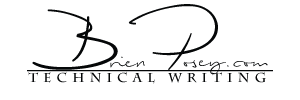Commercial Astronaut Training
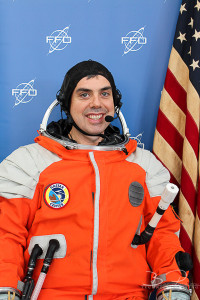
Although Brien Posey is best known for his Information Technology related accomplishments, he is also currently training as a Commercial Scientist-Astronaut Candidate. To date, Brien has completed extensive suborbital space flight training through the Association of Spaceflight Professionals (formerly Astronauts for Hire) and Project PoSSUM (the first private, manned suborbital research program). In addition, Brien leads the Association of Spaceflight Professionals' Technology and Engineering group, which has been tasked with developing new technologies that may eventually fly in space.
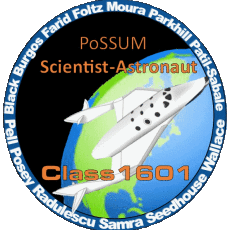
Latest News
- March 2021: Brien is currently preparing for an underwater EVA.
- September 2020: Brien has completed part 1 of his Orbital Mechanics and Mission Simulation training, which will be followed by a suited mission simulation onboard an Orion training capsule.
- March 2020: Read about Brien's spaceflight training in his new blog, Posey's Moonshot.
- March 2020: Brien is going to be participating in phase 3 of Advanced Spacecraft Egress Training, followed by additional training in operational space medicine and lunar geology.
- October 2019: Brien operated an EVA spacesuit under lunar gravity and microgravity conditions, performing a variety of tasks and experiments in the process, at the Canadian Space Agency headquarters in Montreal.
- October 2019: Brien flew on Project PoSSUM's 2019 microgravity flight campaign.
- May 2019: Brien has completed a course in Lunar and Martian field geology in the San Francisco Volcanic Fields of Arizona. The course also involved designing and testing various tools for sample collection during an EVA.
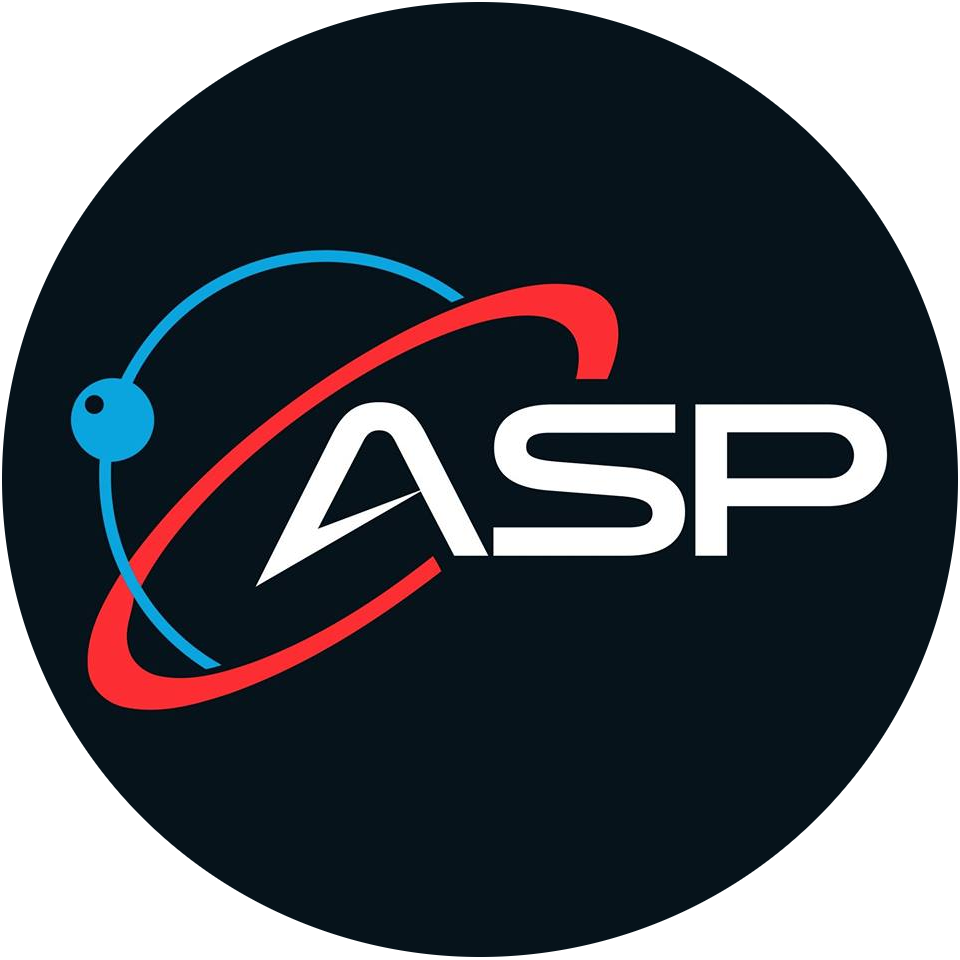
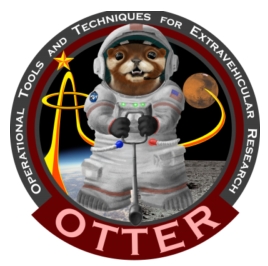
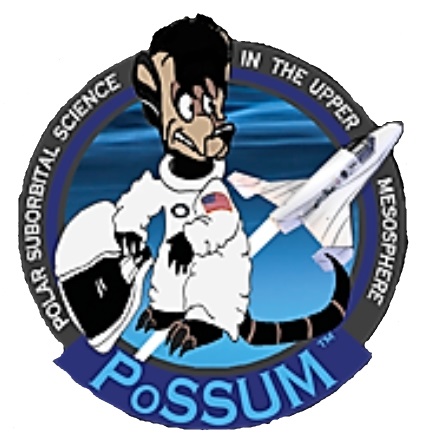
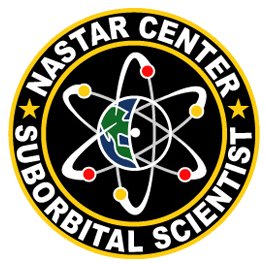
Press
Brooklyn-Built Spacesuits Splash Down in a Connecticut Pool
Final Frontier Design Completes Testing and Validation of IVA Suit
Private Spacesuit Undergoes Zero-G Testing to Prepare for Commercial Flights
New Kind of Spacesuit Being Tested in Ottawa
Project PoSSUM Graduates 13 Scientist-Astronaut Candidates in Class 1601
Follow Brien's spaceflight training adventures on his 1105 Media blog, Posey's Moonshot!
Spaceflight Training and Education
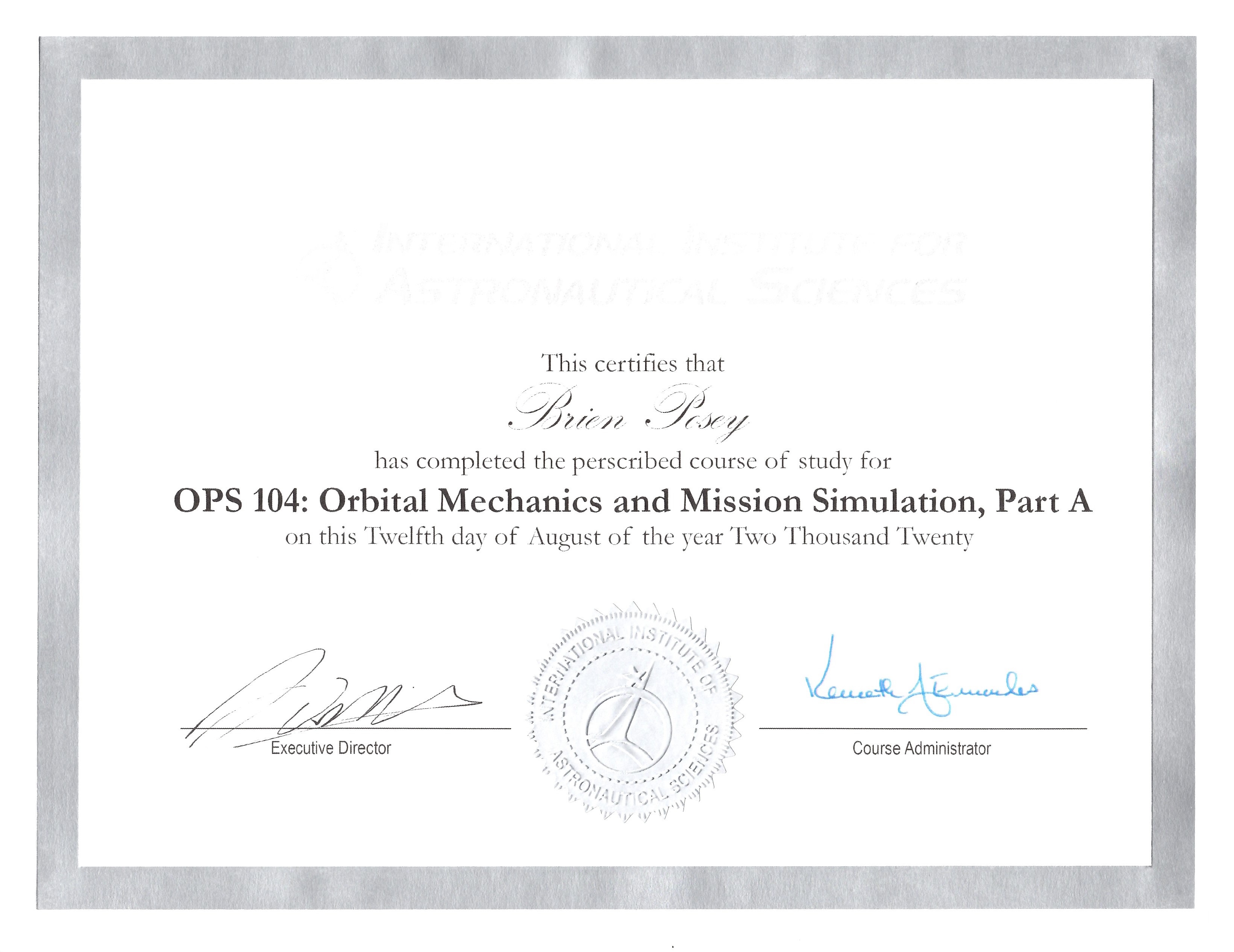
Orbital Mechanics and Mission Simulation
Orbital Mechanics and Mission Simulation, Part A
August 2020
Part 1 provided the astrodynamics foundation, which is 11 weeks of webinar lectures, that provides foundational knowledge of orbital mechanics and attitudinal dynamics to facilitate performance in simulator scenarios. Part 2 will be a four day Orion spacecraft simulator-based mission based on the following objectives:
1. Launch to ISS orbital intercept/rendezvous using space suits.
2. ISS proximity operations and docking, flight suit environment
3. Deorbit and landing scenarios using space suits
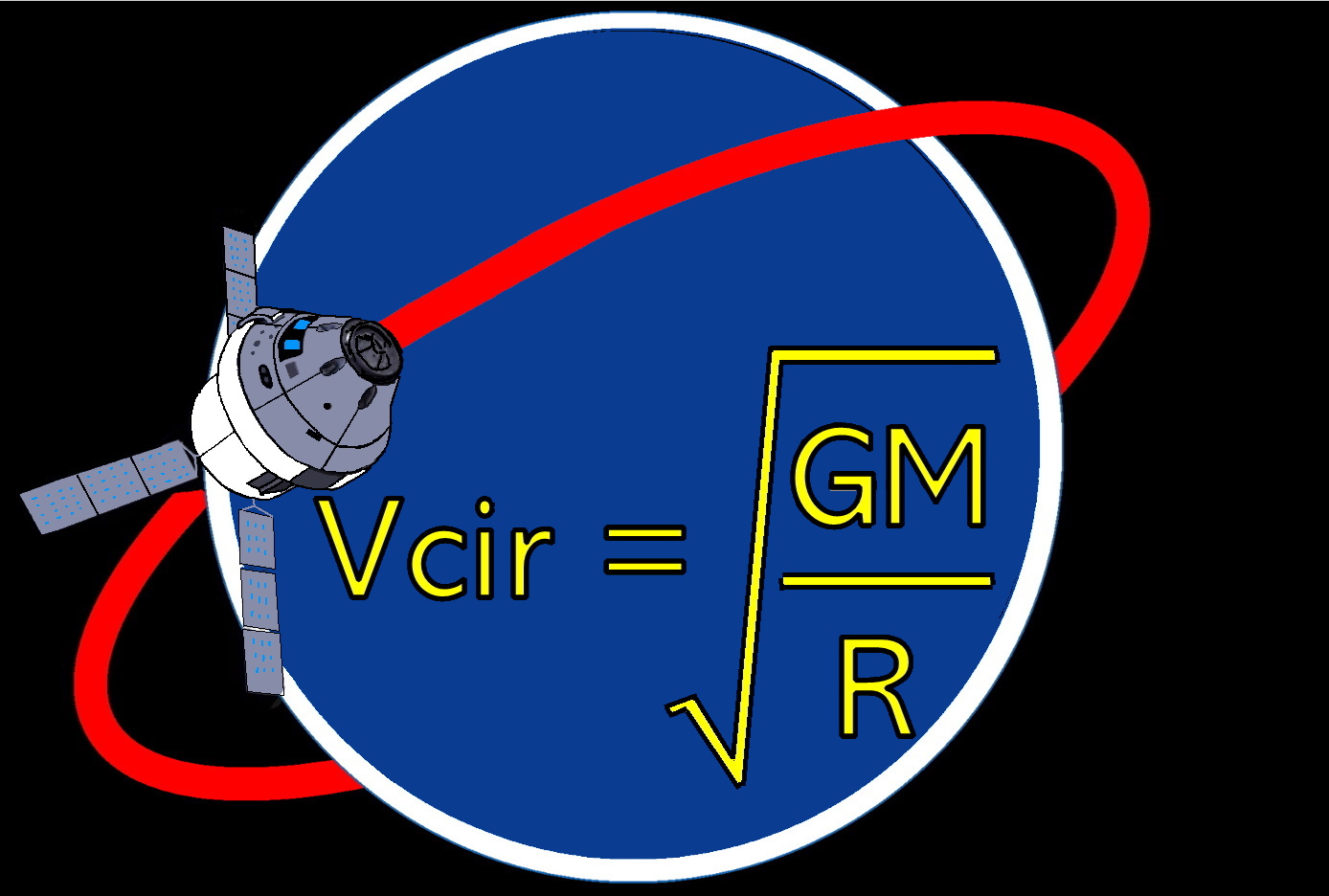
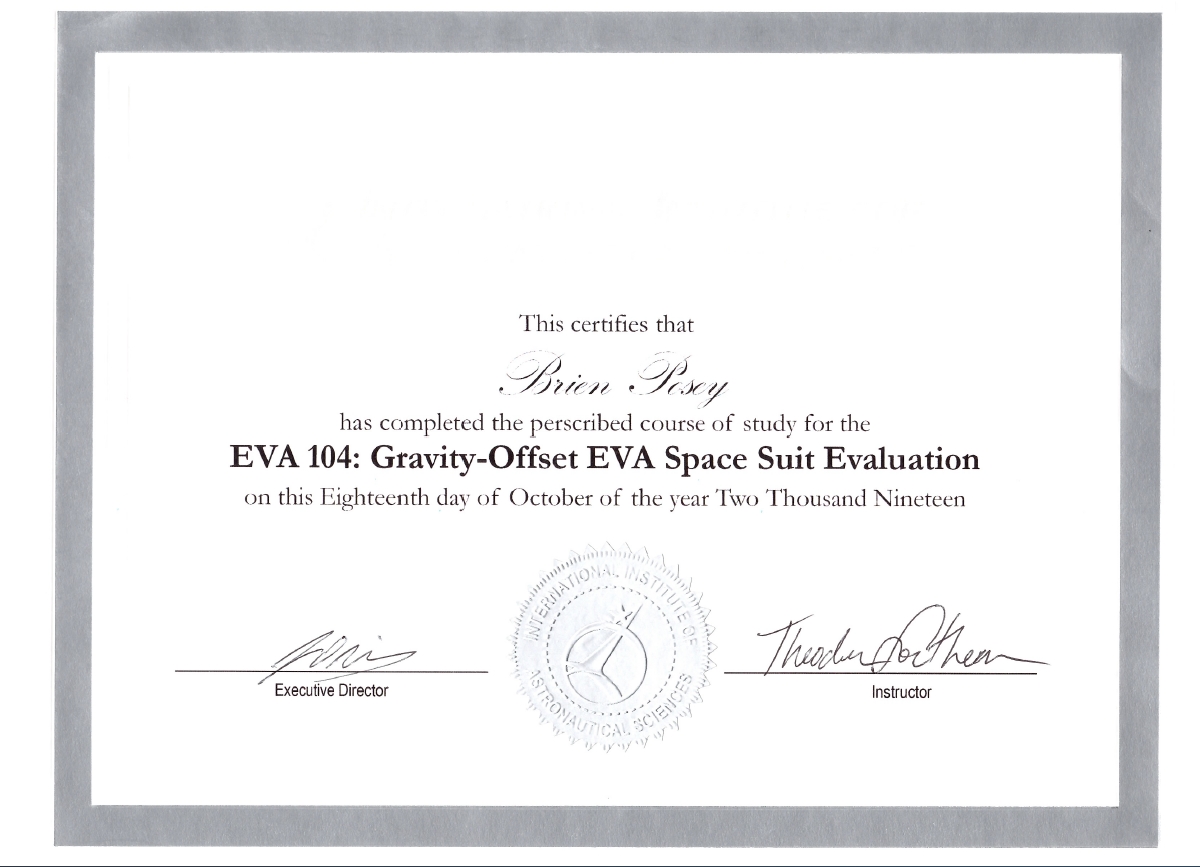
Gravity Offset EVA Spacesuit Evaluation
Gravity Offset EVA Spacesuit Evaluation
Canadian Space Agency, Montreal - October 2019
-
- Operation of an EVA spacesuit under lunar and microgravity conditions
- Evaluation of walking in lunar gravity
- Geological tool evaluations in lunar gravity (hammer, shovel, soil sampler, rock hardness tool)
- LiDAR system evaluation in lunar gravity
- Fluid Line connection in microgravity
- Power and data cable connection in microgravity
- Power tool use in microgravity
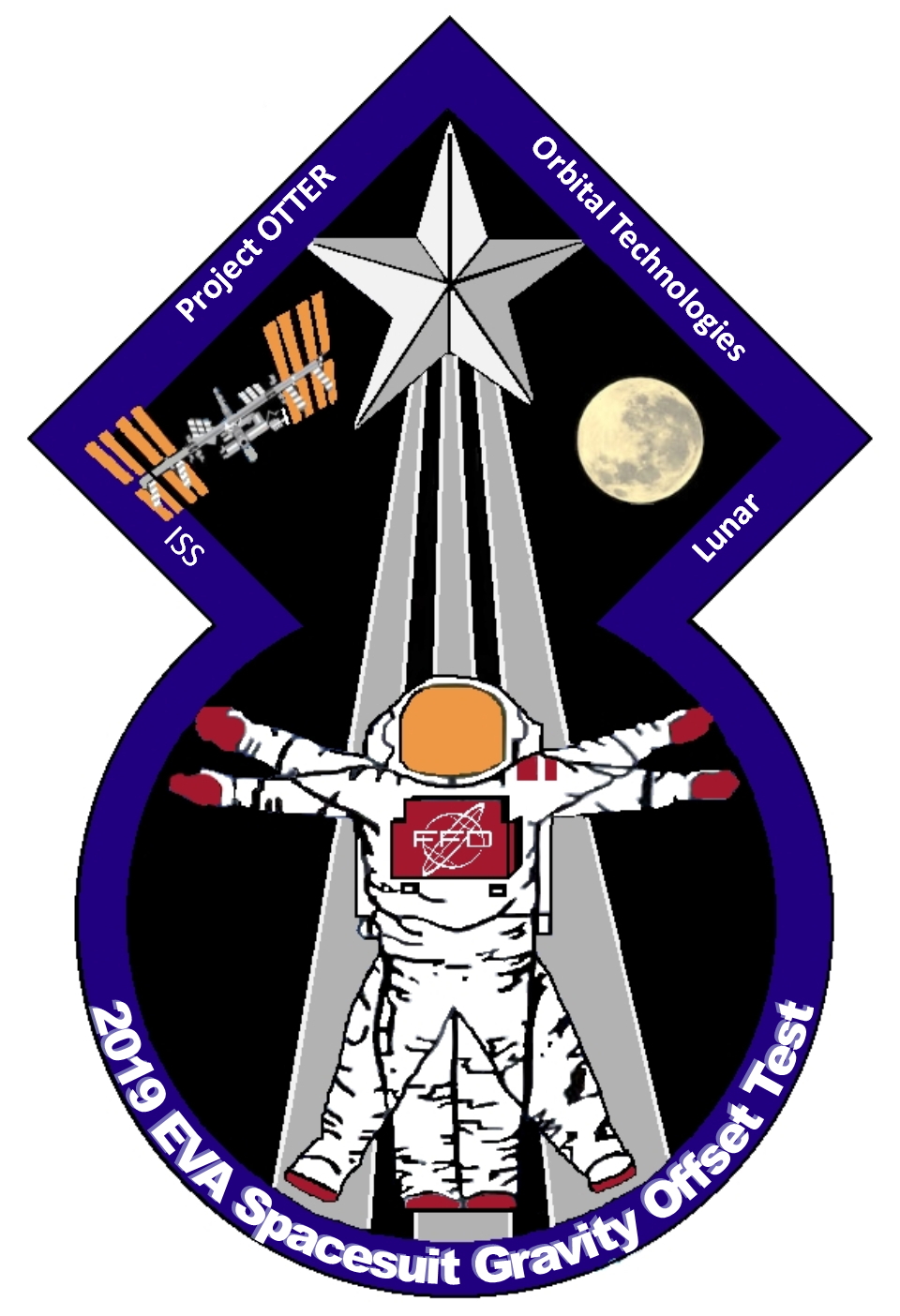
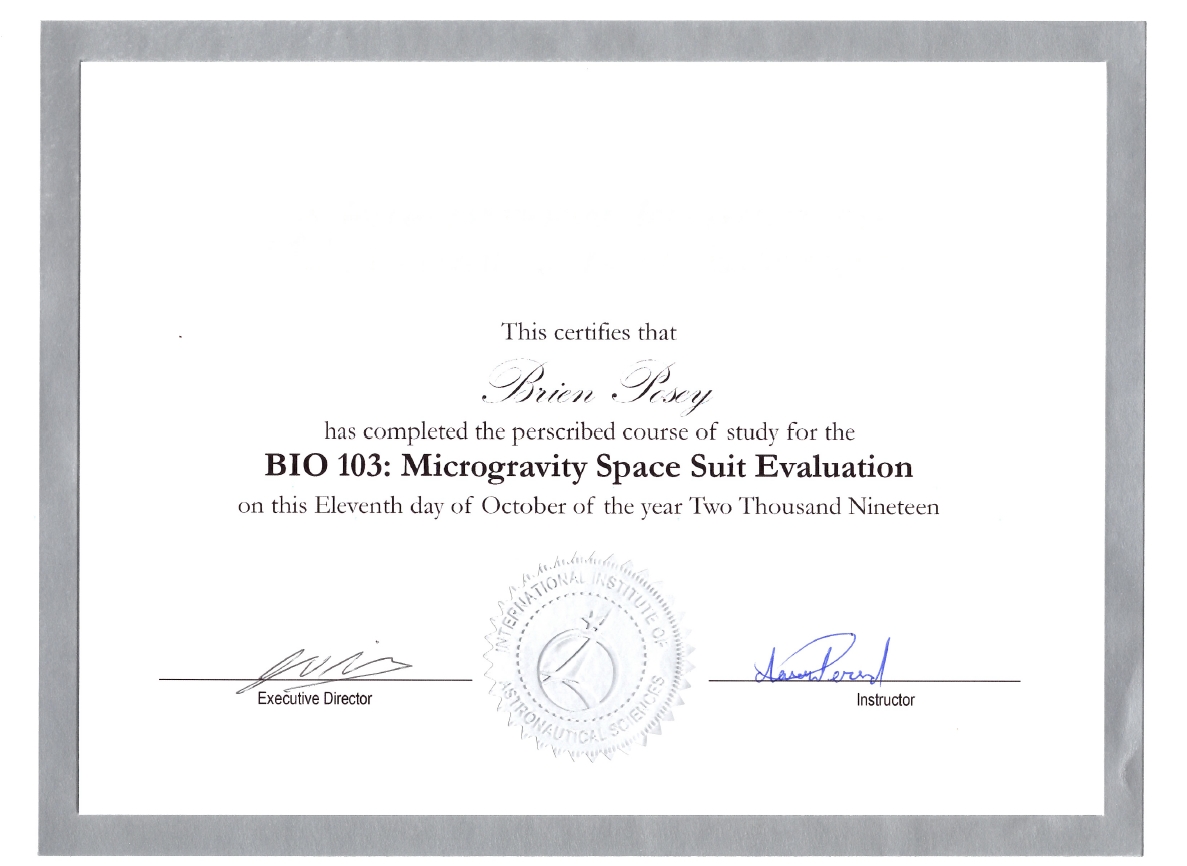
2019 Microgravity Spacesuit Evaluation
2019 Microgravity Spacesuit Evaluation
Canadian National Research Council, Ottawa - October, 2019
My role in the 2019 parabolic flight campaign was that of Test Director. I was responsible for overseeing the experiments being performed and for the crew's safety and well being. Some of the experiments being performed included:
-
- Spacesuit evaluation
- Biomonitoring
- Zero gravity drinking glass
- Evaluation of solar panel deployment on an Egyptian cubesat
- Water behavior in lunar gravity
- VR based radiology suite
- Magnetic force in microgravity
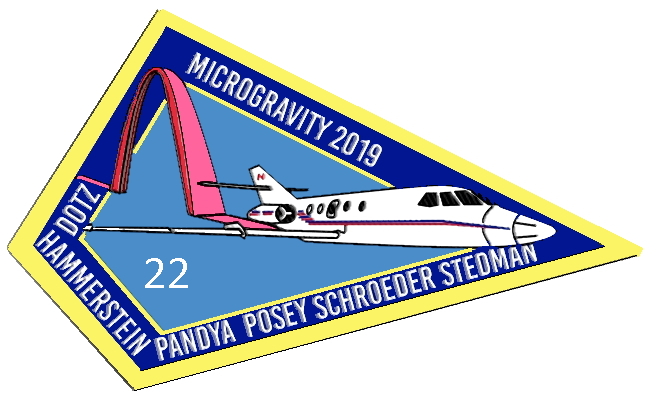
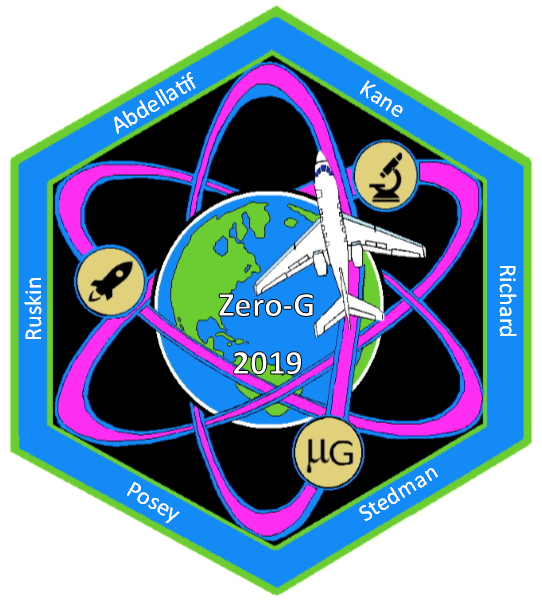
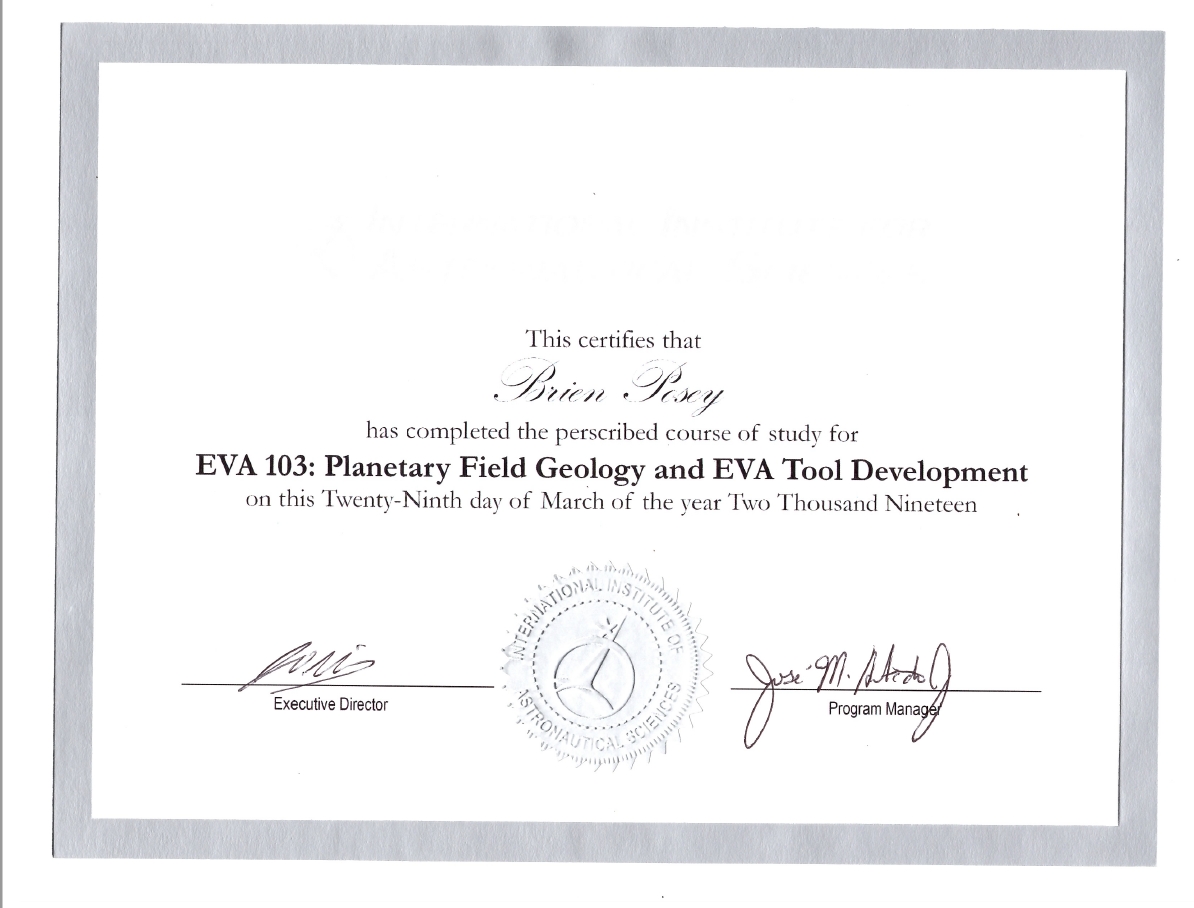
Planetary Field Geology and EVA Tool Development
Planetary Field Geology and EVA Tool Development
Flagstaff, AZ - May 2019
Some of the objectives for this course included:
-
- Study Lunar and Martian geology
- Perform field geology in the San Francisco Volcanic Fields, an area that has been used extensively to train NASA astronauts
- Develop and test tools that are designed to make it easier for a suited astronaut to collect geologic samples on the moon or Mars
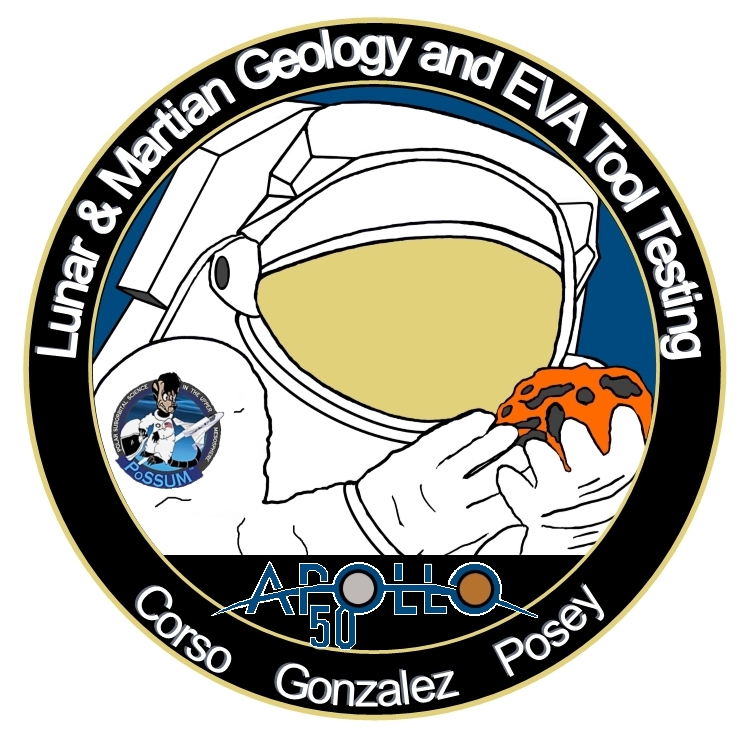
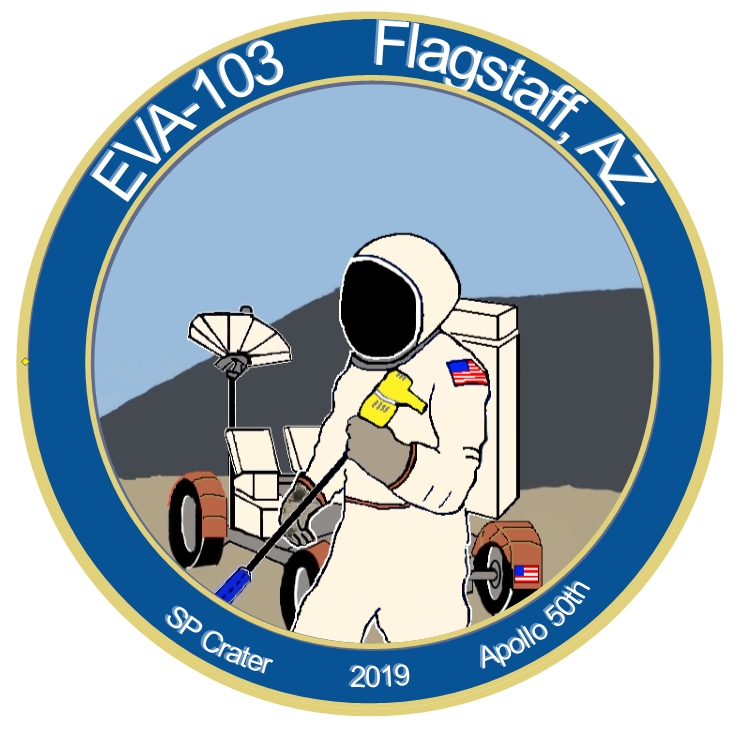
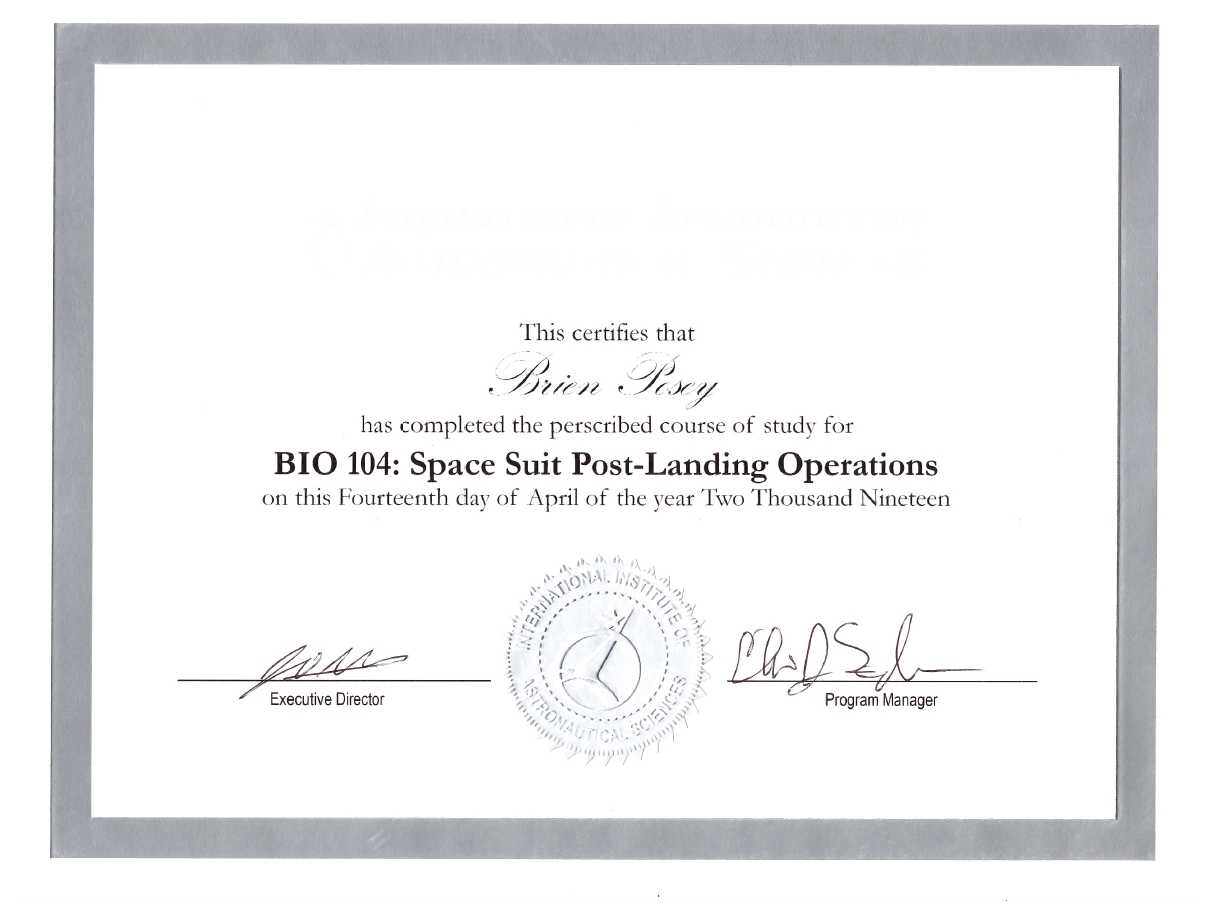
Spacesuit Post-Landing Operations, Phase 2 Testing
Spacesuit Post-Landing Operations, Phase 2 - April 2019
-
- Pressure Suit Safety
- Parachute and Ejection Seat Operations
- Landing and Rescue Operations
- Orion Side Hatch Operations
- Orion Rescue and Recovery
- Suited lift and drop, canopy extraction, raft ingress (Choppy water) day and night
- Forward hatch egress
- Evaluation of LPUs
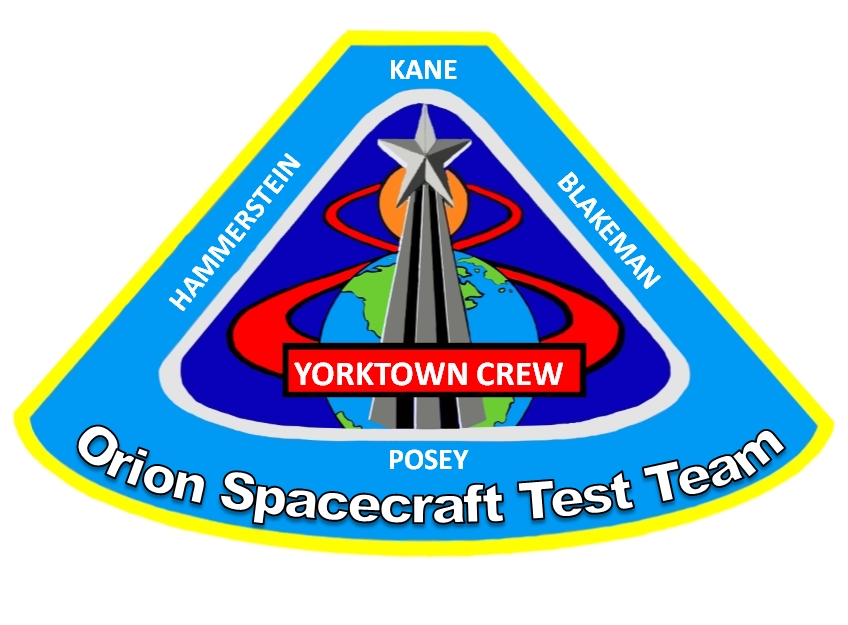
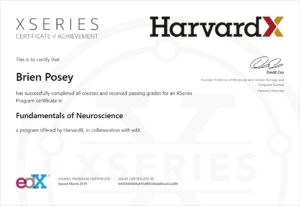
XSeries Certificate in Neuroscience
XSeries Certificate in Neuroscience - March, 2019
Harvard University / EDX
-
- Fundamentals of Neuroscience, Part 1: The Electrical Properties of the Neuron
- Fundamentals of Neuroscience, Part 2: Neurons and Networks
- Fundamentals of Neuroscience, Part 3: The Brain
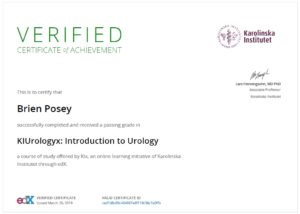
Introduction to Urology
Introduction to Urology - March, 2019
Karolinska Institutet / EDX
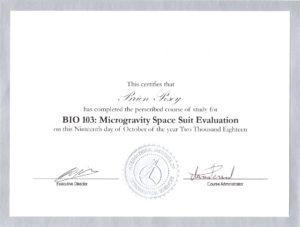
2018 Microgravity Spacesuit Evaluation
2018 Microgravity Spacesuit Evaluation
Canadian National Research Council, Ottawa - October, 2018
My role in the 2018 parabolic flight campaign was that of Test Director for one of the flights. I was responsible for overseeing the experiments being performed and for the crew's safety and well being. The experiments being performed included:
- Intravehicular Activity Space Suit Evaluation in Reduced Gravity - Final Frontier Designs
- Measure biometrics (test sensor performance)
- Test suit sizing, comfort, pressurization to +3.5 psi
- Test air ventilation system (temp, RH, CO2 washout)
- Evaluation of Noise Generated by "Bio Monitor" During Exercise in Reduced Gravity - Canadian Space Agency
- Measure signal noise generated by "Bio Monitor" during movement in reduced gravity
- Test specific exercise motions (rowing and deadlift)
- To support data analysis of David St-Jacques December 2018 ISS mission
- Fluid Configuration Experiment - Massachusetts Institute of Technology
- Determine the stable equilibrium configuration of confined water in reduced gravity
- Determine the cause of contact angle hysteresis
- Measure accelerations with a PocketLabOne
- Solid Body Rotation Experiment - University of Maryland Eastern Shore
- Create a payload to impart known, repeatable angular velocities to objects in the reduced gravity environment
- Measure angular velocities with a PocketLabVoyager
- Project ESPRESSO 2018
- Developing and test new techniques for interacting with asteroid-like material in the asteroid-relevant environments of low gravity and vacuum
- Characterize asteroid material through low-velocity impacts, shearing tests and multiple forms of adhesion or gripping for anchoring and mobility enhancement on the low gravity, airless surfaces of small asteroids
- HoloLens Spacesuit User Interface Test
- Evaluate the suitability of using HoloLens in reduced gravity to display a task list and biometric data
- Hexoskin Microgravity Testing
- Gather data to the usability and data accuracy of the Hexoskin skin shirt while in microgravity
- Food in Space
- A better (“homely”) way to prepare and eat meals in space
- Capture videos of food items in reduced gravity
- Capture video of eating a noodles with chopsticks in 0G
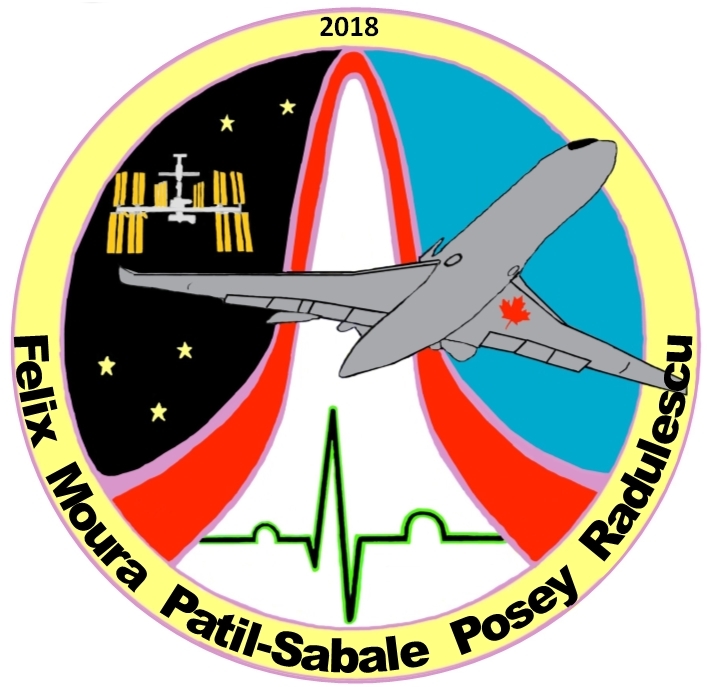
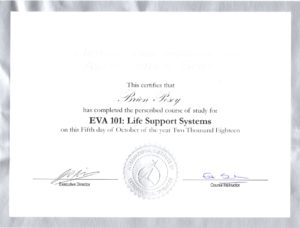
Life Support Systems
Life Support Systems - October, 2018
Topics of study include:
- Human physiology as it relates to spaceflight
- The ISS life support system and its six subsystems
- Air and water reclamation and the requirements for a closed loop system
- Physico-chemical life support systems
- Bioregenerative life support systems
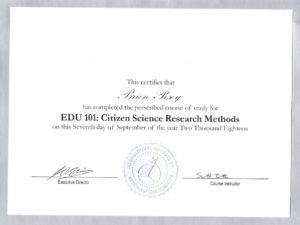
Citizen Science Research Methods
Citizen Science Research Methods - September, 2018
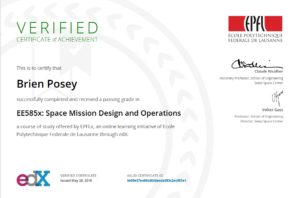
Space Mission Design and Operations
Ecole Polytechnique Federale de Lausanne (Swiss Federal Institute of Technology at Lausanne) / EDX - May 2018
Topics of Study Include:
- Orbital Mechanics
- Orbital Maneuvers, Special Orbits, and Rendezvous
- Interplanetary Trajectories and Propulsion
- Spacecraft Systems
- Human Spaceflight
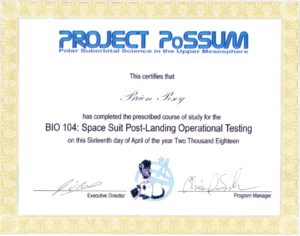
Spacesuit Post Landing Operational Testing
Project PoSSUM - April 2018
Spacesuit use in nominal and off-nominal post-landing environments.
- Parachute and ejection seat operations
- Landing and rescue operations
- Orion Stable 1 Egress Ops (Unsuited, Side Hatch)
- Orion Stable 1 Egress Ops (Unsuited, Front Hatch)
- Orion Stable 1 Egress Ops (Suited Side Hatch, Raft Ingress, Raft Ops (signaling, etc.))
- Orion Stable 1 Egress Ops (Suited Front Hatch, Raft Ingress, Raft Ops (signaling, etc.))
- Parachute Suited Ops in Water (Spacesuit Interface, LPUs, Green Apple, Canopy Release, etc.)
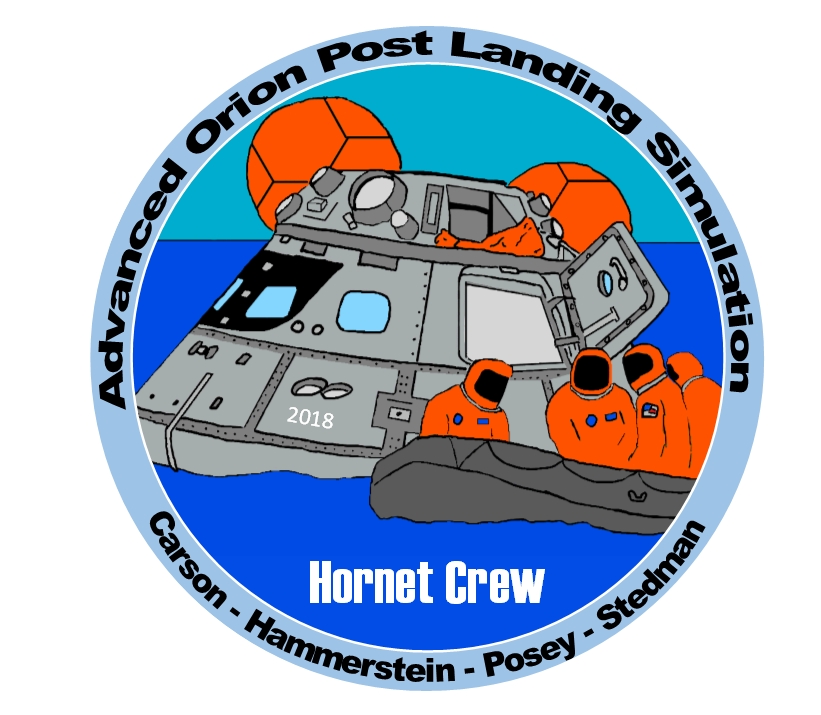
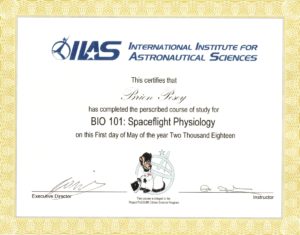
Spaceflight Physiology
Project PoSSUM - April 2018
Physiological changes and adaptations that occur during each phase of spaceflight: ascent, early orbit, long-term flight, extra vehicular activities, and reentry.
Topics of study include:
- The development of biophysics and its impact upon early astronaut medical selection criteria
- Environmental Control / Life Support System: Subsystems, Extra Vehicular Activities, Prebreathe and Decompression Sickness, Toxic Hazards, Trace Contaminants, VOCs, and the SMAC list.
- Cardiovascular Adaptation in Space
- The Neuro-Vestibular System
- Atrophy and the Muscular system
- The Short Term and Long Term Effects of High Doses of Ionizing Radiation
- Psychological Considerations in astronaut selection
- Operational Space Medicine Emergency Rescue Support
- Space Life Sciences Research
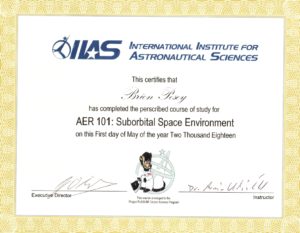
Suborbital Space Environment
Project PoSSUM - April 2018
Fundamentals of aeronomy with an emphasis on the environmental hazards most relevant to the operations of manned spacecraft, including particles and radiation, impact phenomena, spacecraft charging, aerodynamic drag, and oxygen corrosion of surfaces.
Topics of study include:
- Atmospheric structure and large scale circulations, Concept of scale height and barometric formula
- Planetary boundary layer, Coriolis force, Synoptic weather systems and fronts, Atmospheric stability and clouds, Impact of weather on spacecraft operations.
- Stratospheric dynamics, Concepts of potential temperature and potential vorticity, Planetary and gravity waves, Stratospheric ozone chemistry and polar stratospheric clouds
- Principles of radiative transfer, Atmospheric transmission and absorption, Feedback mechanisms
- Mesospheric structure and dynamics, Mesospheric composition and chemistry, Gravity waves and tides, Polar mesospheric clouds
- Thermospheric structure and composition, Energy input – space weather, Ionospheric layers, Airglow and aurora, Environmental effects on spacecraft
- Exobase and atmospheric escape, Van Allen radiation belts, Solar energetic particles and cosmic rays – space weather, Environmental effects on spacecraft
- Mars’ atmospheric structure and dynamics, Mars’ atmospheric composition, Dust and condensates and their radiative effects, Entry, descent and landing of spacecraft on Mars

Celestial Navigation for Space Missions
Project PoSSUM - April 2018
Practical instruction in celestial navigation and how it pertains to suborbital and orbital imaging and remote sensing missions.
Topics of study include:
- Index error, dip and altitude correction for Sun, Moon, Stars and Planet.
- Calculate time of meridian passage of the Sun for any given Longitude.
- Calculation of times of Sunrise, Sunset, and Twilight.
- Observers Latitude by Sun noon or twilight Polaris sights.
- Solving the Celestial triangle using H.O. 249 tables.
- Solving the Celestial triangle using S-tables
- Determining Latitude and Longitude using celestial bodies
- Plotting of Celestial L.O.P. on a Universal Plotting Sheet using simultaneous sights or running sight methods.
- Determination of Azimuths and Altitude of navigational bodies at twilight.
- Calculation of Compass Deviation using Celestial bodies.
- Computing Great Circle routes.
- Setting up and using an artificial horizon.
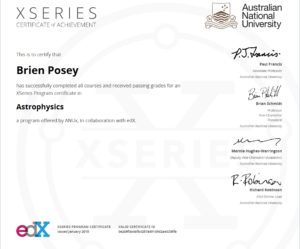
XSeries Certificate in Astrophysics
Australian National University / EDX - January 2018
The Astrophysics XSeries is issued at the successful completion of four individual courses including:
- ANU-ASTRO1X: Astrophysics: Greatest Unsolved Mysteries of the Universe
- ANU-ASTRO2X:Astrophysics: Exploring Exoplanets
- ANU-ASTRO3X: Astrophysics: The Violent Universe
- ANU-ASTRO4X: Astrophysics Cosmology
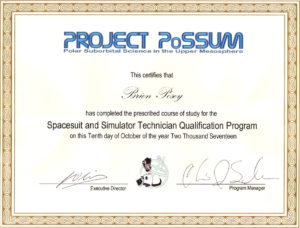
Spacesuit and Simulator Technician Qualification Program
Daytona, Florida - October 2017
- Qualified to pilot the PoSSUM suborbital spaceflight simulator on noctilucent cloud tomography missions
- Trained in the safe donning, doffing, and operational procedures for a Final Frontier Design, Intra-vehicular Activity (IVA) spacesuit
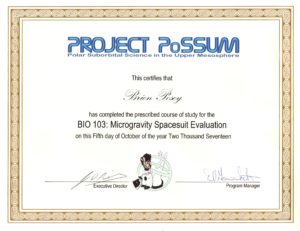
Microgravity Spacesuit Evaluation
Ottawa Canada, October 2017
BIO-103 was the third series of microgravity flight testing for the Final Frontier Design IVA spacesuit. Referred to internally as the "visor down test", this was the first parabolic flight campaign in which the spacesuit's visor was closed and the suit was pressurized. Test objectives included:
- Test the ability of the suited subject to operate the PoSSUM science instruments in microgravity
- Test the subject's ability to operate flight controls
- Test the suited subject's ability to accurately pressurize and depressurize the spacesuit to a predetermined pressure.
- Test the subject's ability to open and close the visor
- Test the suited subject's ability to release and refasten the five point harness while weightless
My role in this flight campaign was that of suited subject, and I was therefore responsible for performing the various tests while wearing a spacesuit.
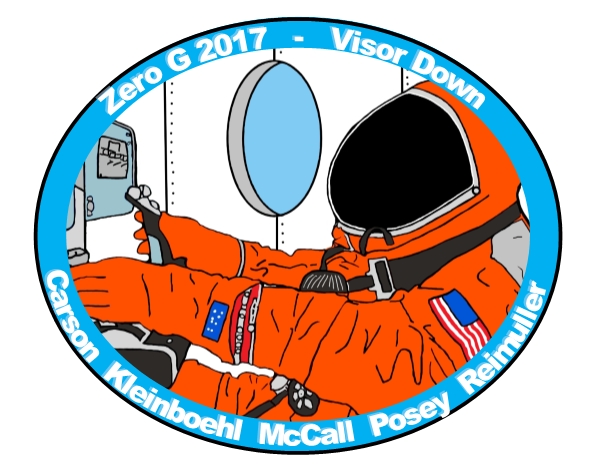
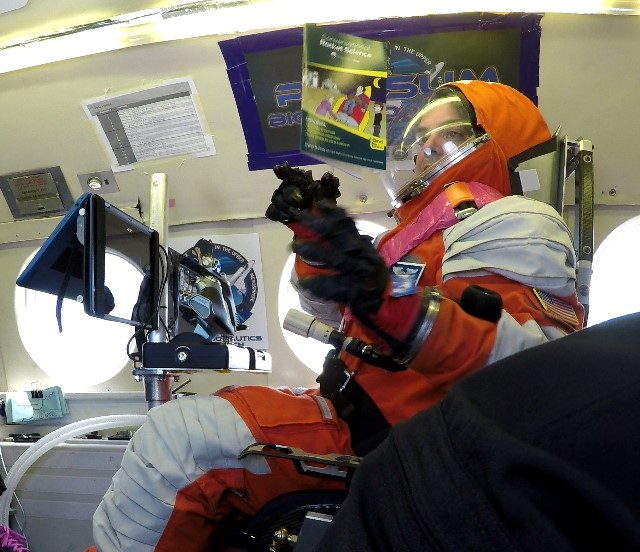
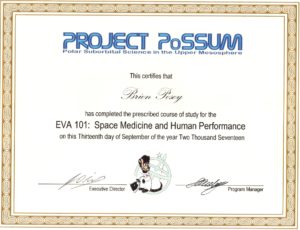
Space Medicine and Human Performance
Project PoSSUM / Project OTTER, September 2017
Space Medicine and Human Performance (EVA-101) focused primarily on post landing contingencies following an off-nominal spacecraft landing in a remote area. In addition to learning about spaceflight physiology and space medicine, the team learned how to triage and treat injuries stemming from an off-nominal landing.
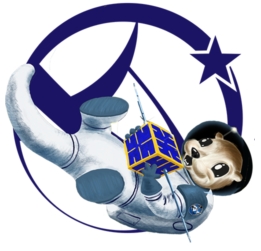
Project OTTER (Orbital Tools and Techniques for Extravehicular Research)
Brien Posey is a member of the inaugural Project OTTER class (EVA-101). Project OTTER is a cooperative effort between Project PoSSUM and Final Frontier Design, with the goal of developing and testing EVA spacesuits. The program will culminate in a series of underwater EVA research missions. The Project OTTER requirements include:
- Project PoSSUM Scientist-Astronaut Qualification Program (prerequisite)
- EVA-101: Space Medicine and Human Performance
- EVA-102: Life Support and EVA Suit Operations
- EVA-103: Extraterrestrial Geology and EVA Tool Development
- EVA-104: Saturation Diving and Analog EVA
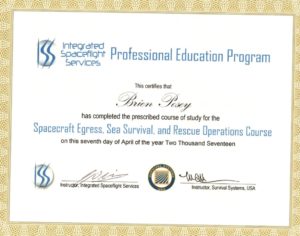
Spacecraft Egress, Sea Survival, and Rescue Operations
Integrated Spaceflight Services / Survival Systems USA, April 2017
Spaceflight-Specific Topics of Study:
- Planning for Nominal and Contingency Landings
- Nominal Rescue Operations
- Contingency Rescue Operations for Land Landing Spacecraft
- International Program-Specific Agreements
- Global SAR Response Resources supporting Contingency Landings
- Contingency Rescue Operations for Water Landing Spacecraft
- Pad Egress Failure Environments, Pad Egress Design and Operations
- Early De-orbit scenarios
- Post-Landing Contingencies
- Egress Systems
- Egress Procedures and Operations
- Assessing Probabilities and Effects of Injuries and Deconditioning
- Assessing the Effects of Deconditioning on Egress Operations
- Incapacitation through Entrapment
- Egress and Post-Landing Operations in the Age of Commercial Manned Spaceflight
- Emergency Post-Landing Survival Kits, Medical Resources
Fundamental Egress and Post-Landing Survivability Skills:
- Safety and survival equipment utilization and deployment
- Coping with physiological and psychological stress
- Introduction of rescue devices and simulated rescues
- Preparation for emergency landing situations in a spacecraft
- Evacuation through an emergency exit from a spacecraft
- Physics and physiology for use of compressed air
- Preflight inspection, egress considerations, and clearing procedures using an EBD
- Conducting an emergency egress on breath hold utilizing the Shallow Water Egress Trainer
- Conducting an emergency egress with an EBD utilizing the Shallow Water Egress Trainer
- Evacuation and escape training utilizing the Modular Egress Training Simulator (METS) with and without utilizing an EBD
Sea Survival Skills:
- Safety and survival equipment utilization and deployment
- Introduction to hypothermia mitigation and sea survival
- Personal rescue techniques and use of life rafts and signaling devices
- Characteristics of personal flotation devices and aviation jackets
- Life raft deployment/entry and simulated emergency scenarios
- Introduction to individual and group sea surface formations
- Introduction to search and rescue resources and equipment
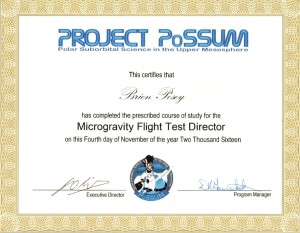
Microgravity Flight Test Director
Project PoSSUM Microgravity Spacesuit Evaluation Program
Canadian National Research Council, 2016
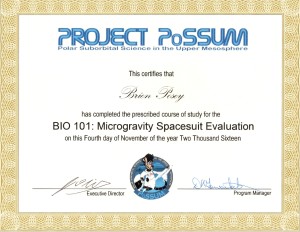
Microgravity Subject Assistant
Project PoSSUM Microgravity Spacesuit Evaluation Program
Canadian National Research Council, 2016
PoSSUM Bioastronautics BIO-101
A microgravity flight campaign to evaluate commercial spacesuits in a microgravity environment in conjunction with a prototype spacecraft seat, and various biomedical monitoring systems. The study focused primarily on human factors, the suit / seat interface, the umbilical interface, the suited subject's ability to operate spacecraft controls, and ingress / egress procedures.
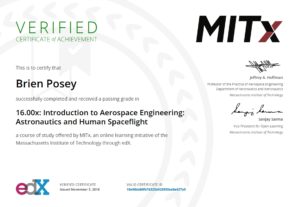
Introduction to Aerospace Engineering: Astronautics and Human Spaceflight
Massachusetts Institute of Technology / EDX - November 2016
Topics of Study Include:
- Rocket Science
- Environmental Control and Life Support Systems
- Orbital Mechanics
- Microgravity and Space Physiology
- Extravehicular Activity
- System Safety
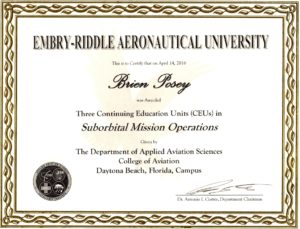
Suborbital Mission Operations
Embry Riddle Aeronautical University
- Department of Applied Aviation Sciences
- Suborbital Mission Operations
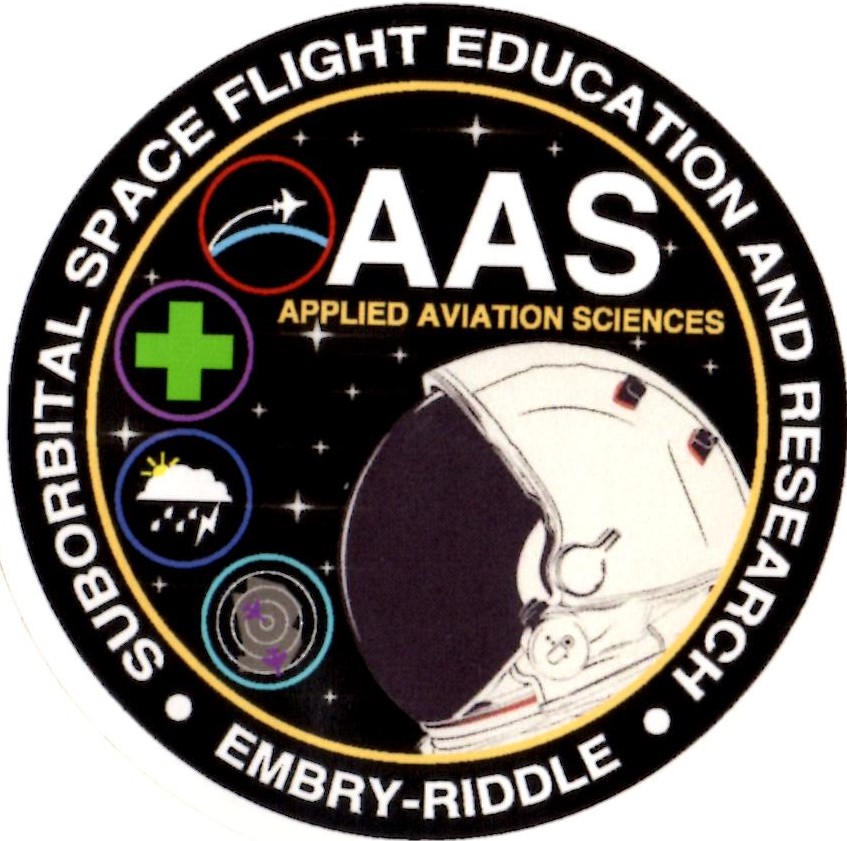
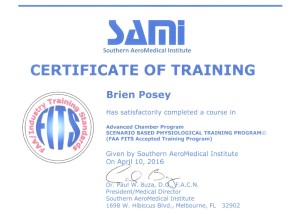
Advanced Chamber Program / Scenario Based Physiological Training Program
Advanced Chamber Program / Scenario Based Physiological Training Program
Southern Aeromedical Institute
Scenario based training for Slow Onset Hypoxia in which the pilot is required to operate a flight simulator, and maintain communications with ATC, while flying at altitude in a hypobaric chamber.
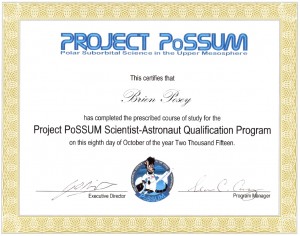
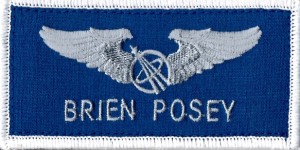
Project PoSSUM Scientist-Astronaut Qualification Program
Embry-Riddle Aeronautical University, 2016
• The Mesosphere and Lower Thermosphere Environment
• Fundamentals of Remote Sensing
• Remote Sensing and Aerospace Cinematography
• Spaceflight Simulation and Operations
• Hypoxia Awareness and Mitigation
• Spacesuit Operations
• High-G Analog and Mitigation Methods
• Introduction to Aerospace Physiology
• Introduction to Life Support Systems
• Fundamentals of Celestial Navigation
• Science Communication and Public Outreach
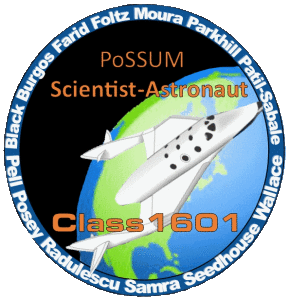
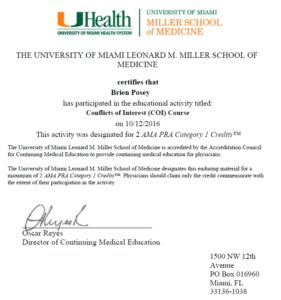
Conflicts of Interest
The University of Miami Leonard M. Miller School of Medicine
Conflicts of Interest (COI)
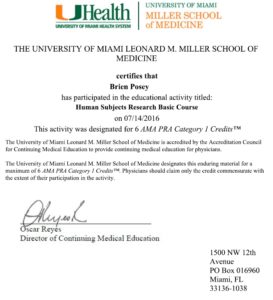
Human Subjects Research
The University of Miami Leonard M. Miller School of Medicine
Human Subjects Research - Biomedical Basic
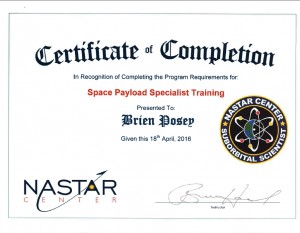
Space Payload Specialist Training / Suborbital Scientist
National Aerospace Training and Research Center, 2016
• Space Research Types
• Environmental Considerations
• Payload Safety Considerations
• Vehicle Types and Operating Environments
• Vehicle Payload Interface
• Operational Considerations in Space
• Time/Distraction Management
• Emergency Procedures & Contingency Planning
• Design and Conduct Experiment in Simulated Space Environment
• Simulated Space Flights to Conduct Experiment in PHOENIX Centrifuge

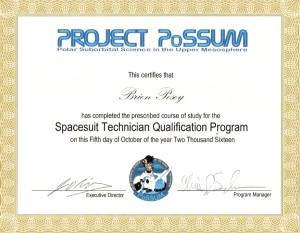
Spacesuit Training and Certification
Final Frontier Designs / Project PoSSUM, 2015-2016
• Protective Equipment & Use
• Altitude Physiology
• Effects of Pressure Change
• Hypoxia & Hyperventilation
• Oxygen & Life Support Systems
• Communications
• Mobility/Maneuverability
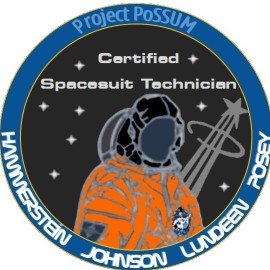
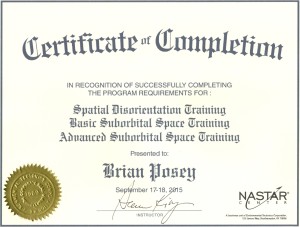
Basic Suborbital Space Training
National Aerospace Training and Research Center, 2015
• Aerospace Environment
• Space Vehicles & Flight
• Motion Environment & Orientation
• Acceleration Forces
• Life Support Systems and Suits
• Space Experience
• Physiological and Psychological Effects
• G Protection, Countermeasures & Skills
• Space Safety and Emergency Procedures
• G Tolerance Flights and Simulated Space Flights
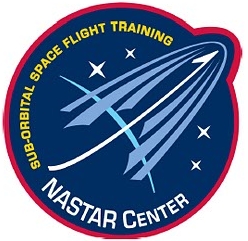
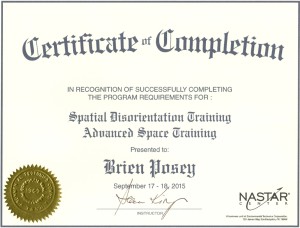
Advanced Suborbital Space Training
National Aerospace Training and Research Center, 2015
• Altitude Physiology
• Spatial Disorientation
• Situational Awareness
• Emergency/Rapid Decompression
• Emergency Procedures & Operations
• Personal Safety & Health
• Aerospace Medicine
• Loss of Control In-flight (LOC-I) Preparation & Flights
• Situational Awareness and Spatial Disorientation Preparation & Flights
• Altitude Chamber Preparation & Flight
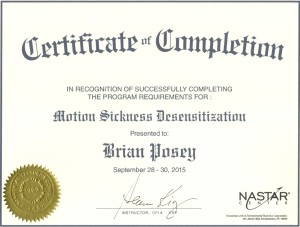
Motion Sickness Desensitization
National Aerospace Training and Research Center, 2015
• This program is adapted from the United States Air Force Airsickness Diagnostics and Prevention Training (ADAPT) program.

Altitude Awareness and Hypoxia Training
Academics
- The physical, physiological and psychological stresses of high-altitude flight
- The physiological-deficient zone (Operations above 10,000 feet MSL)
- Recognizing common hypoxia and hyperventilation symptoms
- Hypoxia and hyperventilation management
- Recovery from a rapid decompression event
- Time of Useful Consciousness (TUC)
Altitude Chamber Flights
- 25,000-foot Hypoxia demonstration flight
- 18,000 foot night vision demonstration flight
- Rapid decompression flight
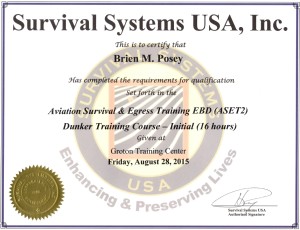
Aviation Survival and Underwater Egress Training
Survival Systems USA, 2015
- Factors that cause water emergencies
- Assess ability to escape from aircraft (fixed wing and helicopter)
- Simulated crashes & survival situations
- On-Board hazards and emergencies
- Firefighting in the cabin/cockpit
- Evacuation and escape
- Aircraft ditching scenarios & techniques
- Search and rescue
- Safety and survival equipment utilization and deployment
- Effects of hypothermia and hyperthermia, mitigation and survival
- Survival psychology
- Personal rescue techniques (signaling, flotation devices, etc.)
- First aid/medical scenarios
- Evacuation training through an emergency exit on water
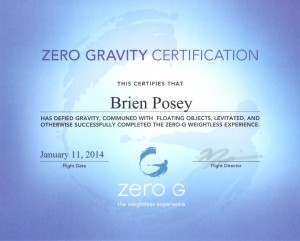
Microgravity Parabolic Flight
Zero Gravity Corporation, 2014
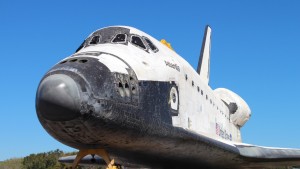
Basic Space Shuttle Systems Orientation
NASA, 2012
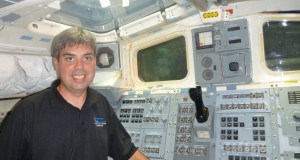
Other Training and Qualifications

Flight Training
Passed the FAA Private Pilot Knowledge Test (Airplane) FAA, 2015
- Student pilot
- Aerobatic flight training
- Altitude chamber training
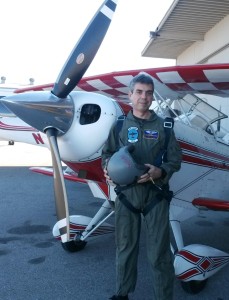
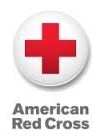
Adult First Aid / CPR / AED
American Red Cross, Since 2015
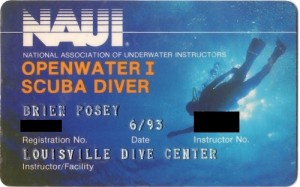
SCUBA Certification
NAUI, 1993
PADI, 2018
Hundreds of dives completed
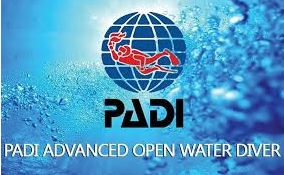
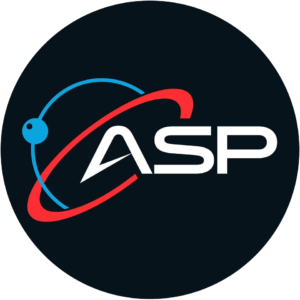
Association of Spaceflight Professionals
Director of the Technology and Engineering Group 2016-2019
Responsible for the development of technologies that may eventually be used on suborbital spaceflights.
